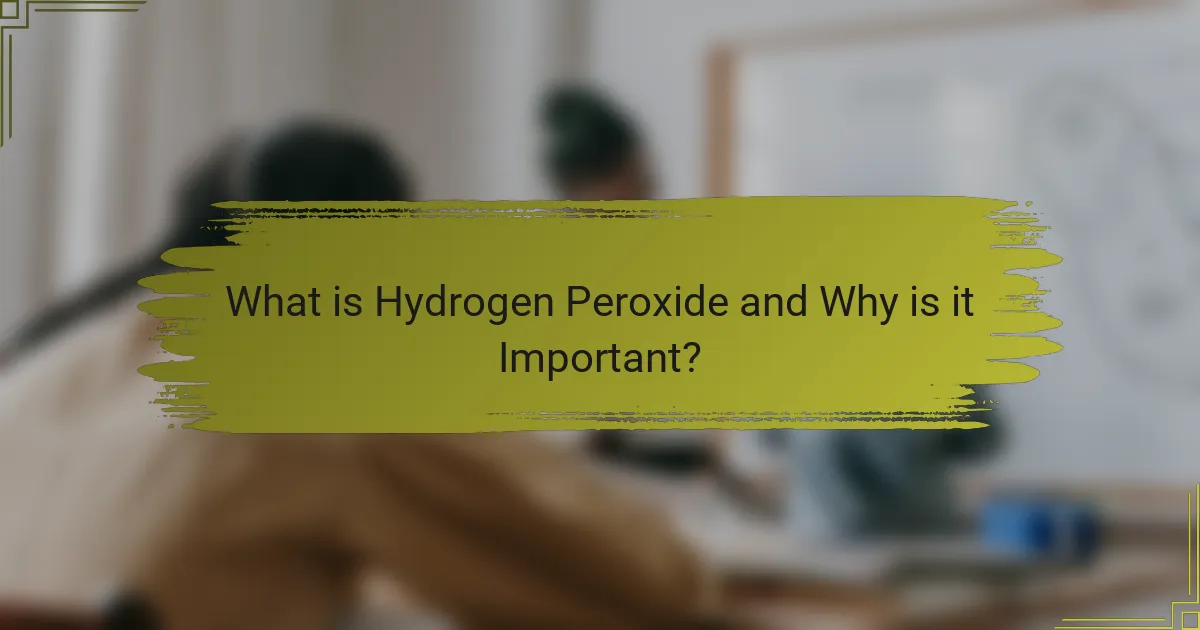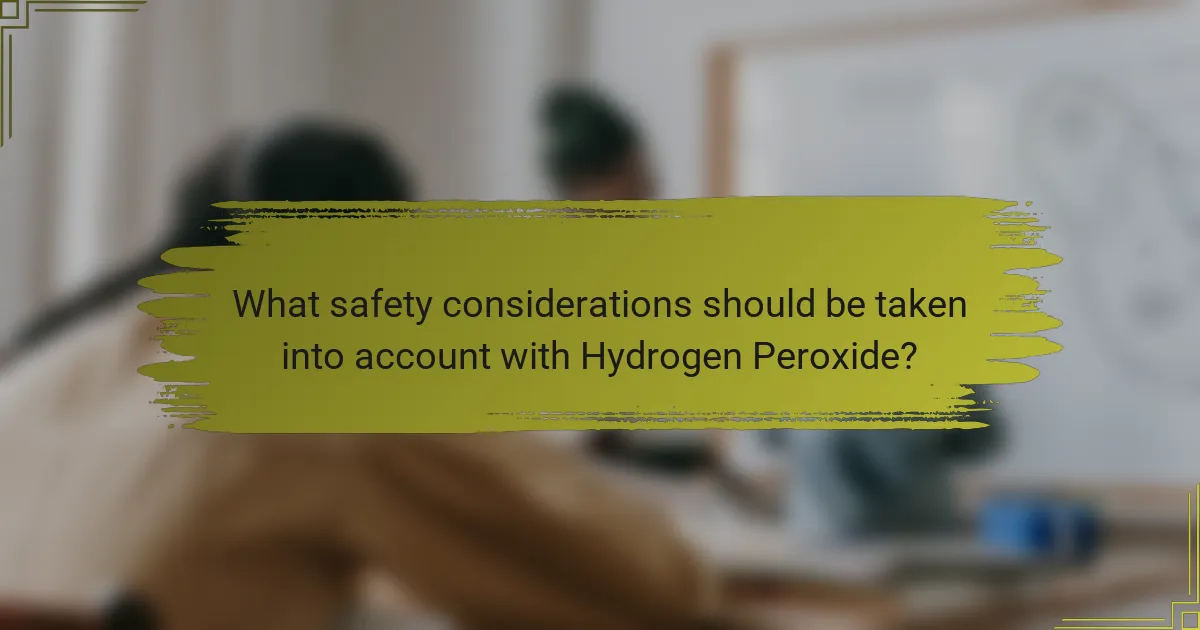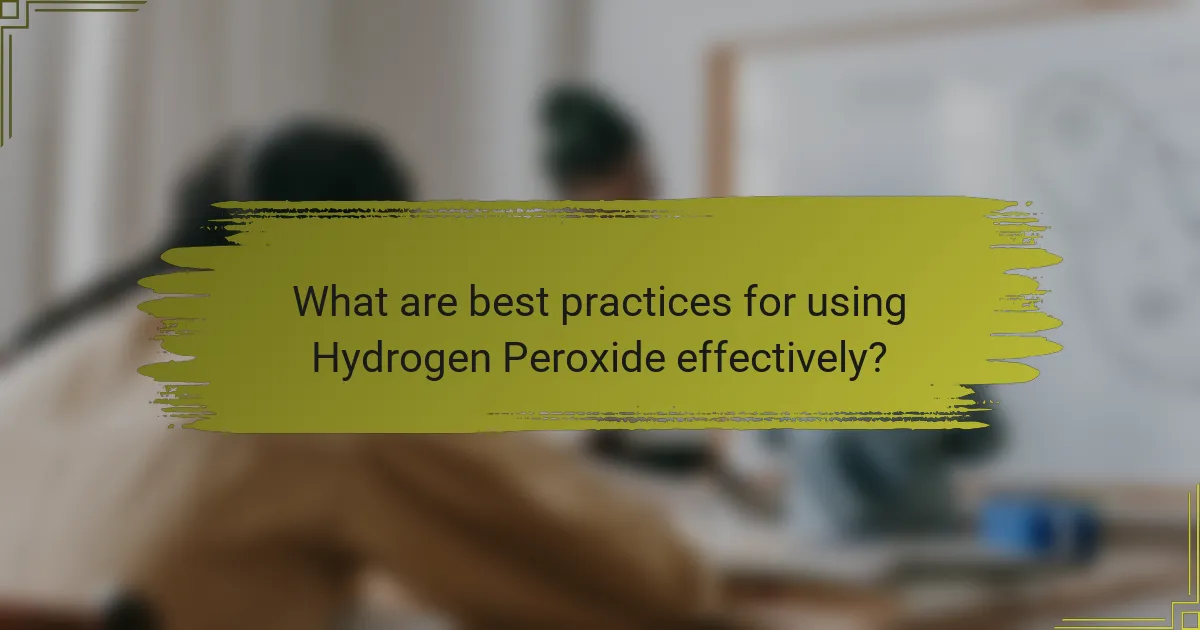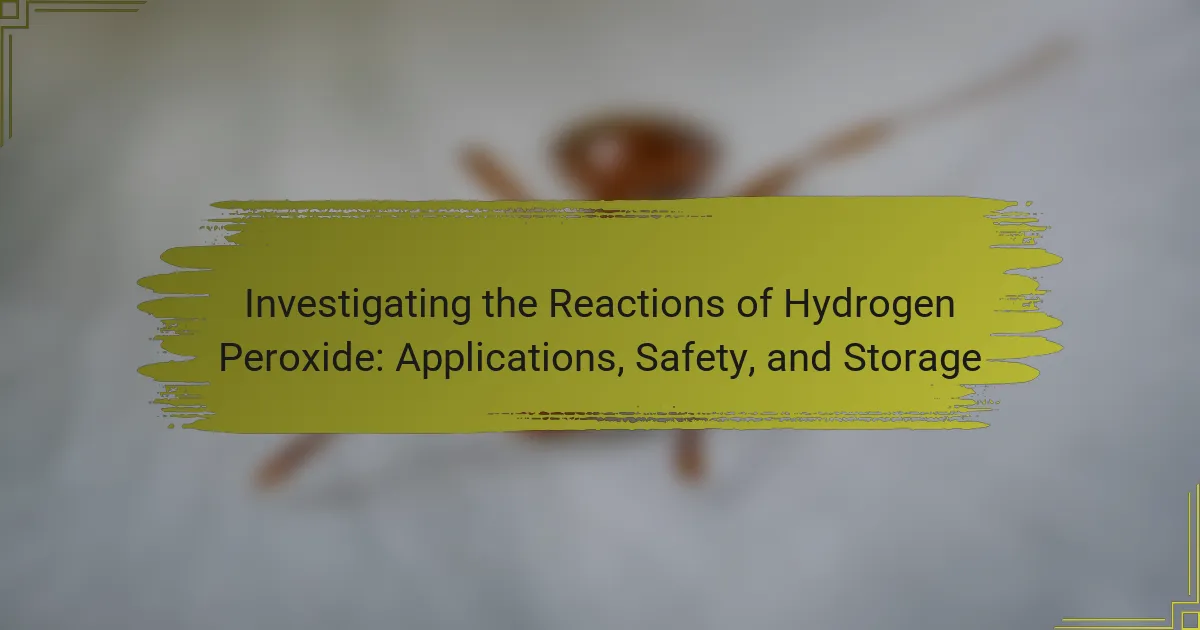
What is Hydrogen Peroxide and Why is it Important?
Hydrogen peroxide is a chemical compound with the formula H2O2. It is a pale blue liquid that appears colorless in dilute solutions. Hydrogen peroxide is important due to its strong oxidizing properties. It is widely used as a disinfectant and bleaching agent. In medical settings, it serves as an antiseptic for minor cuts and abrasions. Additionally, hydrogen peroxide is utilized in various industrial processes, including textile and paper bleaching. Its ability to decompose into water and oxygen makes it environmentally friendly. This compound is also significant in environmental applications, such as wastewater treatment.
How does Hydrogen Peroxide react chemically?
Hydrogen peroxide (H2O2) reacts chemically as an oxidizing agent. It can decompose into water and oxygen gas, especially in the presence of heat or catalysts. This decomposition reaction can be represented as 2 H2O2 → 2 H2O + O2. Hydrogen peroxide can also react with various substances, including metals and organic compounds, leading to oxidation. For instance, it can oxidize iron (Fe) to iron(III) ions (Fe3+). This property makes hydrogen peroxide useful in disinfection and bleaching applications.
What are the primary reactions of Hydrogen Peroxide?
Hydrogen peroxide primarily undergoes decomposition, producing water and oxygen. This reaction is catalyzed by enzymes such as catalase. It can also react with organic compounds, leading to oxidation. In the presence of acids, it can form peracetic acid. Furthermore, hydrogen peroxide can participate in redox reactions, acting as both an oxidizing and reducing agent. These reactions are significant in various applications, including disinfection and bleaching. The decomposition reaction is exothermic, releasing heat.
What factors influence the reactions of Hydrogen Peroxide?
The reactions of Hydrogen Peroxide are influenced by concentration, temperature, and the presence of catalysts. Higher concentrations of Hydrogen Peroxide increase reaction rates. Elevated temperatures also accelerate reactions due to increased molecular activity. Catalysts, such as manganese dioxide, significantly enhance the decomposition of Hydrogen Peroxide. Additionally, pH levels can affect the stability and reactivity of Hydrogen Peroxide. Light exposure can lead to photodecomposition, further influencing reaction rates. Understanding these factors is crucial for safely handling and applying Hydrogen Peroxide in various contexts.
What are the common applications of Hydrogen Peroxide?
Hydrogen peroxide is commonly used as a disinfectant, bleaching agent, and oxidizer. In healthcare, it serves as an antiseptic for minor cuts and abrasions. It effectively eliminates bacteria, viruses, and fungi on surfaces. In the household, hydrogen peroxide is utilized for cleaning and stain removal. It also acts as a whitening agent in laundry. In food processing, it is used for sanitizing equipment and surfaces. Additionally, hydrogen peroxide is employed in water treatment to remove contaminants. Its versatility stems from its strong oxidative properties.
How is Hydrogen Peroxide used in healthcare?
Hydrogen peroxide is used in healthcare primarily as an antiseptic. It is effective in killing bacteria, viruses, and fungi. Healthcare professionals utilize it for wound cleaning and disinfection. The typical concentration used for skin antisepsis is 3%. Higher concentrations may be used for specific applications, such as sterilizing medical equipment. Studies have shown that hydrogen peroxide can reduce infection rates in surgical wounds. Its effervescent action helps to remove debris from wounds. Additionally, it is used in oral care products for its antibacterial properties. Overall, hydrogen peroxide is a versatile agent in healthcare settings.
What role does Hydrogen Peroxide play in environmental applications?
Hydrogen peroxide plays a significant role in environmental applications as a powerful oxidizing agent. It is widely used for water treatment processes to remove contaminants. Hydrogen peroxide effectively breaks down organic pollutants and disinfects water sources. In soil remediation, it aids in the breakdown of hazardous substances. The compound also helps in controlling odors by oxidizing odor-causing compounds. Its application in agriculture includes improving soil health and controlling pests without harmful residues. Studies have shown that hydrogen peroxide can enhance the degradation of certain pesticides in the environment. This versatility makes hydrogen peroxide a valuable tool for sustainable environmental management.
How is Hydrogen Peroxide utilized in industrial processes?
Hydrogen peroxide is utilized in industrial processes primarily as a bleaching agent and oxidizer. In the paper industry, it is used to bleach wood pulp, resulting in a brighter product. The textile industry employs hydrogen peroxide for bleaching fabrics and as a disinfectant. Additionally, it serves as an oxidizing agent in chemical manufacturing, facilitating various reactions. Hydrogen peroxide is also used in the production of propylene oxide, a key component in plastics. Furthermore, it acts as a cleaning agent in the food industry, ensuring sanitation in processing environments. Its effectiveness in these applications is supported by its strong oxidizing properties, which enable efficient chemical reactions.

What safety considerations should be taken into account with Hydrogen Peroxide?
Hydrogen peroxide is a strong oxidizing agent that requires careful handling. It can cause skin and eye irritation upon contact. Always wear protective gloves and goggles when using it. Store hydrogen peroxide in a cool, dark place to prevent decomposition. Ensure containers are tightly sealed to avoid spills. Keep it away from heat sources and incompatible materials like organic substances. In case of ingestion, seek medical attention immediately. Proper ventilation is necessary to avoid inhaling vapors. Following these safety precautions minimizes risks associated with hydrogen peroxide use.
What are the potential hazards of Hydrogen Peroxide?
Hydrogen peroxide can pose several potential hazards. It is a strong oxidizer that can cause fire and explosion risks when in contact with organic materials. Skin and eye contact can result in irritation or burns. Inhalation of vapors can lead to respiratory issues. Ingestion can cause gastrointestinal distress and other serious health effects. Concentrated solutions, typically above 30%, increase these hazards significantly. Proper handling and storage are essential to mitigate these risks.
How can exposure to Hydrogen Peroxide be harmful?
Exposure to hydrogen peroxide can be harmful due to its oxidative properties. It can cause skin irritation upon contact, leading to redness and burning sensations. Inhalation of vapors may irritate the respiratory tract, resulting in coughing and difficulty breathing. Ingesting hydrogen peroxide can lead to gastrointestinal distress, including nausea and vomiting. High concentrations can cause severe damage to tissues, including chemical burns. The National Institute for Occupational Safety and Health (NIOSH) states that exposure to concentrations above 10% can be particularly dangerous. Therefore, appropriate safety measures are essential when handling hydrogen peroxide.
What precautions should be taken when handling Hydrogen Peroxide?
Always wear appropriate personal protective equipment (PPE) when handling hydrogen peroxide. This includes gloves, goggles, and lab coats to prevent skin and eye contact. Use hydrogen peroxide in a well-ventilated area to avoid inhalation of vapors. Store hydrogen peroxide in a cool, dark place away from direct sunlight and heat sources. Keep it in a container that is compatible and labeled correctly to prevent accidental mixing with incompatible substances. Do not mix hydrogen peroxide with acids or bases, as this can lead to hazardous reactions. Dispose of any spills immediately using appropriate neutralizing agents. Always read and follow the Safety Data Sheet (SDS) for specific handling instructions.
How should Hydrogen Peroxide be stored safely?
Hydrogen peroxide should be stored in a cool, dark place. It is sensitive to light and heat, which can cause it to decompose. Use opaque containers to limit light exposure. Keep the storage area well-ventilated to prevent the buildup of vapors. Ensure the container is tightly sealed to avoid contamination. Avoid storing hydrogen peroxide near strong acids or bases, as they can react with it. The stability of hydrogen peroxide is significantly enhanced when stored at temperatures below 25°C (77°F).
What are the ideal storage conditions for Hydrogen Peroxide?
Hydrogen peroxide should be stored in a cool, dark place. Ideal temperatures range from 15 to 30 degrees Celsius. It must be kept in a container that is opaque to prevent light exposure. Light can decompose hydrogen peroxide, reducing its effectiveness. Additionally, the storage container should be made of materials like plastic or glass. These materials prevent reactions that can occur with metals. Hydrogen peroxide should also be kept away from heat sources and direct sunlight. Proper storage extends its shelf life and maintains its stability.
How can improper storage affect Hydrogen Peroxide’s stability?
Improper storage can significantly reduce Hydrogen Peroxide’s stability. Exposure to light can cause decomposition, leading to the release of oxygen gas. High temperatures also accelerate this breakdown. Additionally, storing Hydrogen Peroxide in metal containers can catalyze its decomposition. The presence of impurities can further destabilize the solution. For example, a concentration of 3% Hydrogen Peroxide can lose potency when improperly stored. These factors can lead to a decreased effectiveness in applications.

What are best practices for using Hydrogen Peroxide effectively?
Use Hydrogen Peroxide at the correct concentration for its intended purpose. For disinfection, a 3% solution is typically effective. Ensure proper ventilation when using it to avoid inhalation of fumes. Always wear gloves and eye protection to prevent skin and eye irritation. Store Hydrogen Peroxide in a cool, dark place to maintain its stability. Do not mix it with vinegar or other acids, as this can produce harmful gases. Dispose of expired or unused Hydrogen Peroxide according to local regulations. Regularly check the expiration date, as its effectiveness decreases over time.
How can users maximize the benefits of Hydrogen Peroxide?
Users can maximize the benefits of hydrogen peroxide by using it at the appropriate concentrations. For disinfection, a 3% solution is effective against bacteria and viruses. Users should apply it directly to surfaces and allow it to sit for at least 10 minutes for optimal results. For wound care, a diluted solution can help cleanse minor cuts. However, it should not be used on deep wounds or large areas of skin. Regularly replacing hydrogen peroxide every six months ensures its effectiveness, as it degrades over time. Storing it in a dark container protects it from light, which can cause decomposition. Following these guidelines enhances its efficacy and safety in various applications.
What tips should be followed for safe application of Hydrogen Peroxide?
Use gloves and goggles when applying hydrogen peroxide. This helps protect skin and eyes from irritation. Always work in a well-ventilated area to avoid inhaling fumes. Store hydrogen peroxide in a cool, dark place to maintain its effectiveness. Do not mix hydrogen peroxide with vinegar or other chemicals. This can create harmful reactions. Check the concentration before use; 3% is safe for household applications. Dispose of any unused solution according to local regulations. Always read and follow the label instructions for specific guidance.
How can users troubleshoot common issues with Hydrogen Peroxide?
Users can troubleshoot common issues with hydrogen peroxide by checking its concentration and storage conditions. If hydrogen peroxide is ineffective, verify that it is not expired. Hydrogen peroxide degrades over time, especially when exposed to light and heat. Ensure it is stored in a cool, dark place in a tightly sealed container. For issues with bubbling or fizzing, confirm that the surface is clean. Contaminants can inhibit its effectiveness. If it turns brown, this indicates decomposition. Users should replace it with a fresh bottle. For skin irritation, dilute with water to reduce concentration. Always follow safety guidelines when handling hydrogen peroxide.
Hydrogen peroxide (H2O2) is a pale blue liquid known for its strong oxidizing properties, making it valuable in various applications, including disinfection, bleaching, and environmental management. This article explores the chemical reactions of hydrogen peroxide, its common uses in healthcare and industry, and the safety precautions necessary for its handling and storage. Key topics include the factors influencing its reactions, potential hazards associated with exposure, and best practices for effective application. Understanding these aspects is essential for maximizing the benefits of hydrogen peroxide while ensuring user safety.
